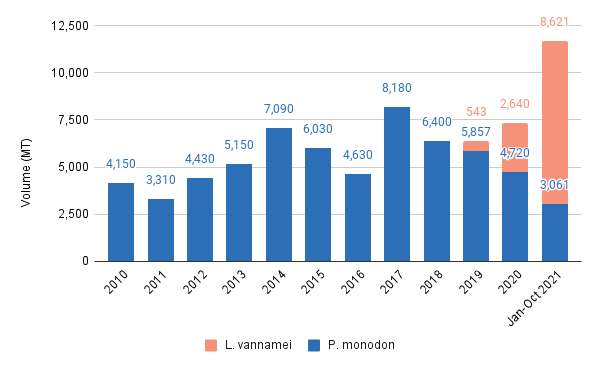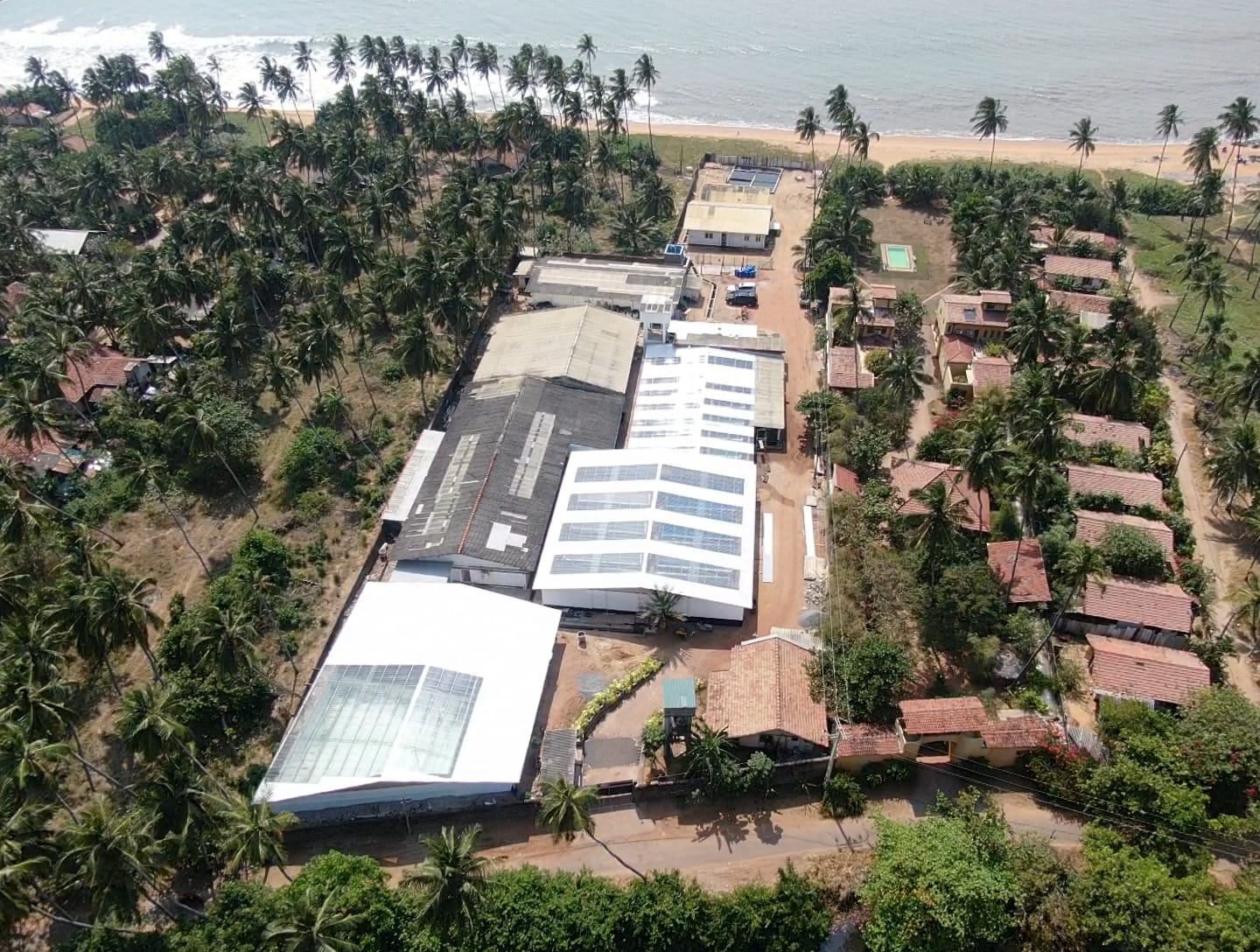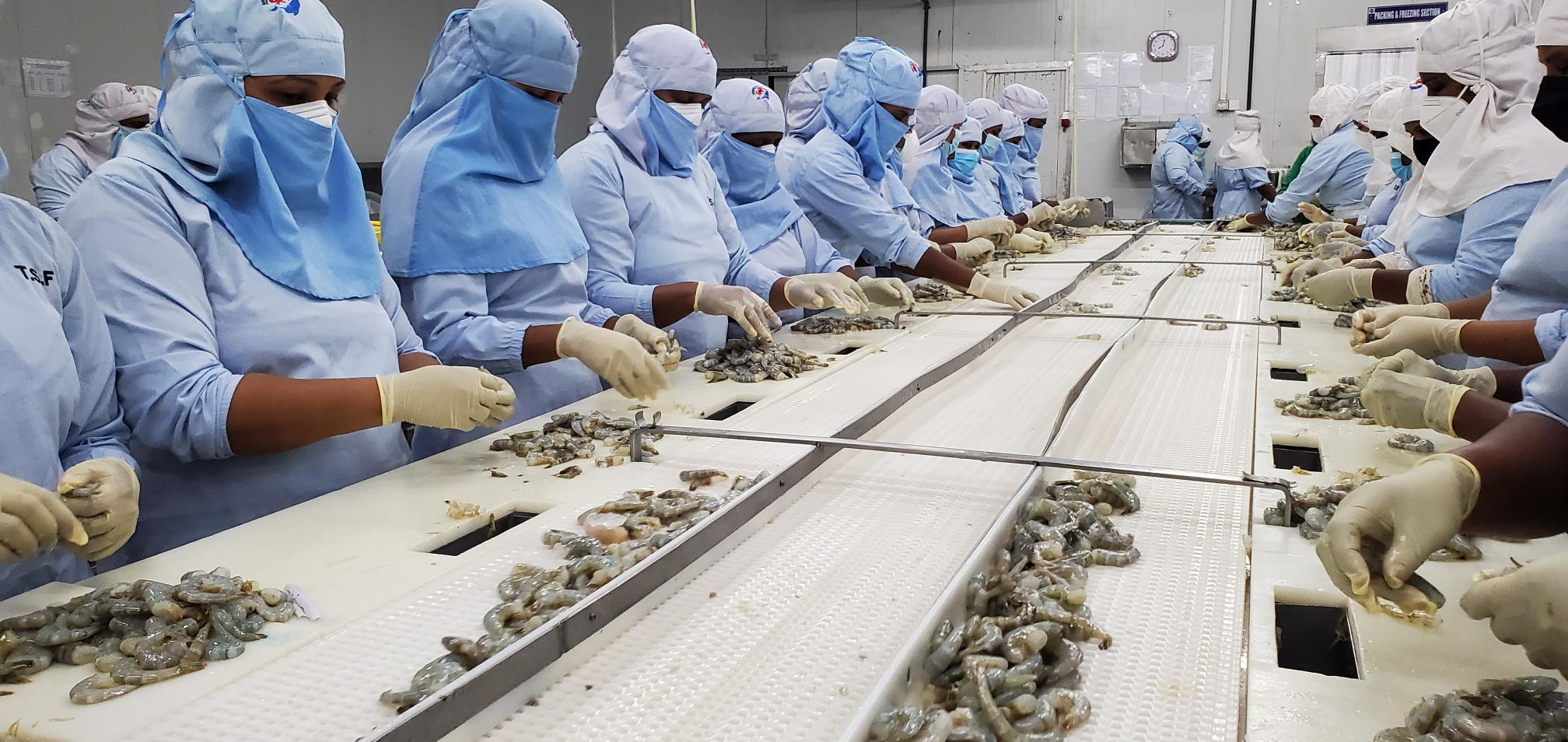Shortly before leaving Seafood Tip in January 2021, I published a ShrimpTails blog about recent developments in Sri Lanka. While the country was oriented towards P. monodon, in 2019, its government approved the import and cultivation of SPF L. vannamei broodstock in specific regions and in the entire country in early 2020. At that time, Tim O’Reilly (Managing Director of Taprobane Seafood Group (TSG)) and Dilan Fernando (owner of TSG and President of Sri Lanka’s Seafood Exporters Association) were among the persons that reached out to me. They did so again recently and said that this year, despite COVID-19 challenges, Sri Lanka is set to produce 16,000 MT of shrimp – even though before the introduction of L. vannamei the country only produced 8,000 MT annually. TSG is a driving force behind Sri Lanka’s transition to L. vannamei. Although the target of 50,000 MT by 2022 that was announced last year might be overly optimistic, Fernando is convinced that in 2022, Sri Lanka will produce at least 25,000 MT.
The Shrimp blog is sponsored by Grobest, Inve Aquaculture, DSM Animal Nutrition, American Penaeid Inc., Zeigler Nutrition, Aqua Pharma Group, Mega Supply, and Undercurrent News.
Video 1: Taprobane Seafood Group's Corporate Video With Footage of One of Its Corporate Shrimp Farms from 20:00-24:00.
P. MONODON PRODUCTION DEVELOPED IN THE 1970S BUT NEVER REALIZED ITS POTENTIAL
As described in the ShrimpTails blog, shrimp farming in Sri Lanka started on its east coast in the late 1970s, but those operations were abandoned due to civil unrest. A new shrimp farming area was developed in the early 1980s along the Puttalam district coast in the north-western part of the country. There, the industry flourished due to the abundance of lagoons, swamps, tidal flats and estuaries well-suited to shrimp farming. The district’s vicinity to key infrastructure such as ports and processing facilities also contributed to the industry’s expansion.
Moreover, in recent years, commercial shrimp farming has developed north of Puttalam in the Mannar district. The new farms in Mannar are mainly of a larger scale. Mannar is also the location of TSG’s shrimp farm. This recent expansion was most likely the cause of production increasing from around 4,000 MT to around 8,000 MT in 2019.

THIS YEAR 75% OF SRI LANKA'S SHRIMP PRODUCTION MAY CONSIST OF L. VANNAMEI
The transition of P. monodon to L. vannamei is happening fast (see Figure 1), even at a higher pace than we’ve seen in India. The fact that most Sri Lankan farms were already using semi-intensive systems when they were still focused on P. monodon made the switch in species fairly easy. Although farms need to comply with stringent biosecurity guidelines for the cultivation of L. vannamei, especially designed to increase production but safeguard the environment, most of them don’t need to make major changes to their production systems. The Sri Lankan government offers low-interest loans that will help farmers convert to HDPE liners and enhance biosecurity. From large to small-scale farmers, many have already started transitioning to L. vannamei. While Fernando expects that 2021 production will amount to 16,000 MT, he is convinced that production in 2022 will reach 25,000 MT.

Figure 1: Sri Lanka’s Shrimp Production from 2010-2021

Source: NAQDA, Sri Lanka
Upon inquiry, Hon. State Minister of Fisheries of Sri Lanka, Kanchana Wijesekera, mentioned that the government approved the conversion of 1,000 extensive ponds to intensive L. vannamei farms at a single location early November. Land in three other parts of the country has also been recently approved for the cultivation of L. vannamei and the ambition is to start farming in these locations in 2022. Altogether, the additional land allocated to the production of L. vannamei totals 4,000 acres. Farmers in these locations will gain access to the government’s low-interest loan scheme (4%). This will bring the total number of clusters in the L. vannamei sector to five: Mannar, Puttalam, Batticalo, Jaffna and Hambantota. Each cluster will be dedicated as a shrimp farming zone with low-barrier approval processes to encourage farmers to get involved. The government expects TSG and other private sector stakeholders to play a crucial role in developing these areas. Once fully developed, the Minister states that annual production of 50,000 MT should be achievable.

TAPROBANE SEAFOOD GROUP (TSG) AND LOTUS AQUACULTURE PLAYED A CRUCIAL ROLE IN INITIATING THE TRANSITION
Taprobane Seafood Group (TSG) and Lotus Aquaculture (a JV with CP Foods) played a crucial role in the initial introduction of L. vannamei in Sri Lanka. TSG has been of great importance in working with the government to set up the rules and regulations at each level of the supply chain, ensuring a successful introduction of L. vannamei. Once the government decided to allow L. vannamei cultivation in the country, both companies received a permit to import SPF broodstock. Lotus Aquaculture, partly owned by CP Aquaculture India, imports its broodstock – both L. vannamei and P. monodon – from CP Foods in Thailand. TSG imports its broodstock – only L. vannamei – from Kona Bay and Shrimp Improvement Systems in Hawaii and Florida. The Sri Lankan government has banned the use of wild-caught P. monodon spawners, and therefore the hatchery operations of TSG and Lotus Aquaculture play such a key role. According to TSG, today it dominates the L. vannamei PL market with a market share of around 90%, while Lotus Aquaculture dominates the market of SPF P. monodon PL.

Photo 1: TSG’s hatchery in Sri Lanka

Source: Taprobane Seafood Group
TSG OWNS 45% MARKET SHARE OF SRI LANKA’S TOTAL SHRIMP EXPORTS
TSG’s first corporate farm is built on a 57-acre former extensive P. monodon farm in Mannar and is designed as a model farm for others in the country. The company used existing land and almost 100% of the water used in the farm is recirculated. The farm is multitrophic with tilapia, oyster and sea cucumber, and has a multi-phase design allowing for short production cycles. David Kawahigashi, owner of Vannamei 101, visited TSG’s farm in 2019 and views its design as a great leap forward for sustainable shrimp farming. In 2019, the farm produced around 1,500 MT of L. vannamei and in 2021, TSG expects it to produce 1,800 MT.

Besides its farm in Mannar, TSG owns two other farms and has one farm under management. A large-scale circular tank farm that will produce 4,000 MT per year is scheduled to be ready by 2023 and another two of these farms are in the development stage. The company aims to produce 10,000 MT of L. vannamei per year at its own farms and to buy from a large number of independent farmers. According to Fernando, TSG already has a 45% market share of shrimp production and exports. Other major exporters include Alpex (20%), Ceylon Catch (10%) and Prawn Ceylon (10%). If TSG realizes its ambition to reach 10,000 MT of annual production, it may soon grow into a major South Asian shrimp exporter.
Photo 2: A small-scale farm in Sri Lanka using a multi-phase model with circular tanks and rectangular ponds.

Source: Taprobane Seafood Group
But it doesn’t stop there for TSG. The company has already been raising investments and plans to raise more from private equity funds and international development banks. With fresh capital, the company aims to further vertically integrate its operation by setting up a local feed mill. However, before that time, TSG will start selling feed under its own brand name from December 2021 and offer farmers equipment and technical services. With the capacity to offer PL and feed, TSG aims to implement a buy-back system, gaining access to a large amount of raw materials from the farms that use its inputs. Fernando expects that having a feed mill in Sri Lanka will make shrimp production in the country even more competitive and will cause the industry to grow further.

WITH BAP 3* AND A POSITIVE SEAFOOD WATCH RECOMMENDATION, TSG AIMS FOR HIGHER-END MARKET SEGMENTS
Since the fourth quarter of 2021, TSG is BAP 3* certified, providing the company access to major retailers and food service companies that buy certified seafood only. While TSG is currently the only certified producer in Sri Lanka, Fernando and O’Reilly are eager to motivate others to follow them in certifying their farms and other production facilities. Although not ASC certified yet, TSG aims to obtain ASC approval for a number of its new high-tech farms with circular tanks and conversations with ASC on this topic have already started.
Photo 3: Shrimp processing at TSG’s facility in Sri Lanka

Source: Taprobane Seafood Group
To further strengthen not only its own profile but also the profile of Sri Lanka as a whole, Fernando and O’Reilly aim to work with Monterey Bay Aquarium’s Seafood Watch program to obtain a yellow (good alternative) or green (best choice) recommendation for Sri Lanka. Having experience in this endeavor with Sri Lanka’s blue swimming crab (P. pelagicus), O’Reilly is convinced they can achieve the same for Sri Lanka’s L. vannamei.

CONCLUSION
While the aforementioned production target of 50,000 MT by 2023 might be a bit far-fetched, Sri Lanka seems to be well on its way to become a niche origin of certified L. vannamei with a story. The country’s GSP+ status and its accompanying 0% import duties in the EU make it an interesting source of shrimp.
I rarely write blogs with so much focus on one company, but TSG is such a driving force behind Sri Lanka’s shrimp sector that I feel it’s justified. To realize its ambitions, TSG will need many partners, suppliers, clients and investors. I hope that this blog encourages you to contact TSG if you’d like to know more.
Thanks to Kanchana Wijesekera (Hon. State Minister of Fisheries of Sri Lanka), Dilan Fernando (owner of TSG and President of Sri Lanka’s Seafood Exporters Association) and Tim O’Reilly (Managing Director of TSG) for contributing to this blog.